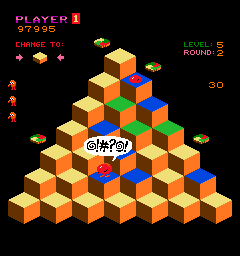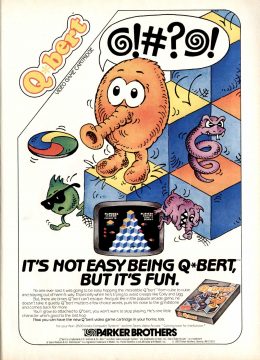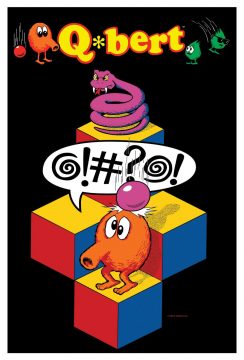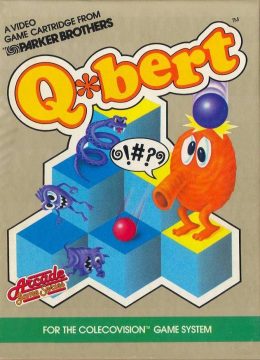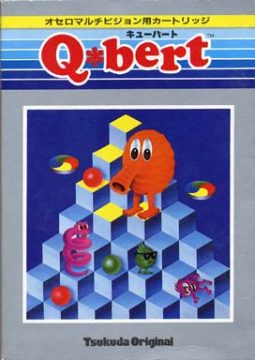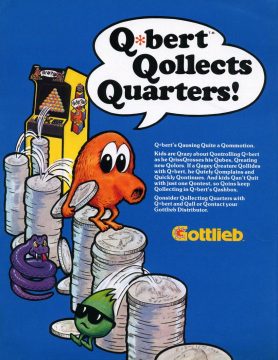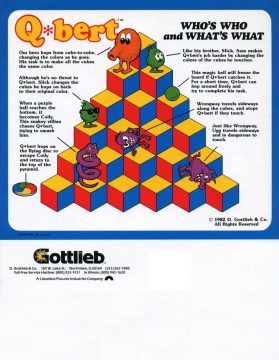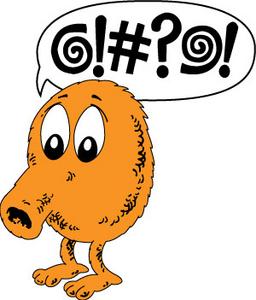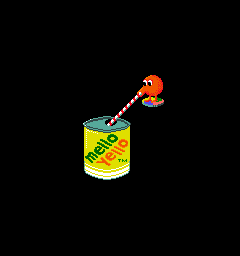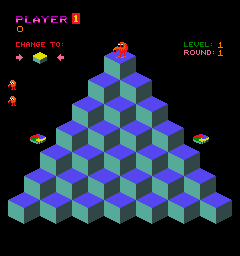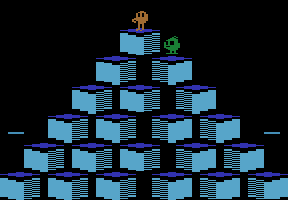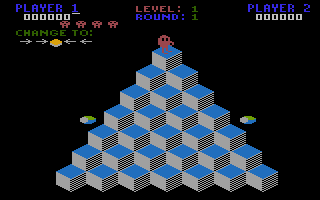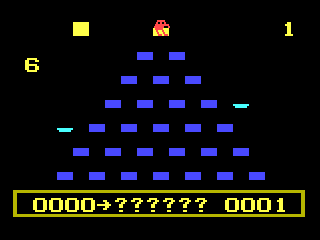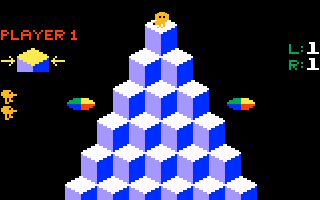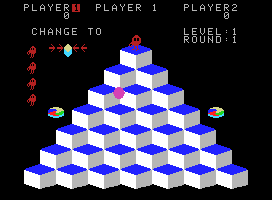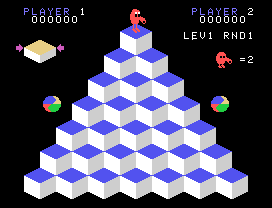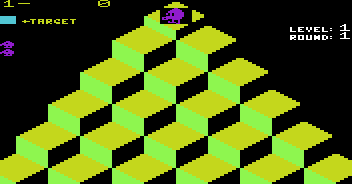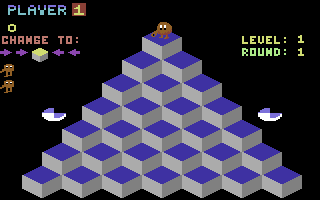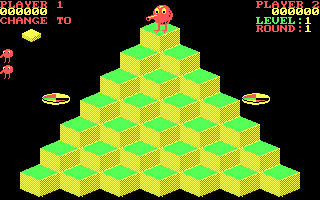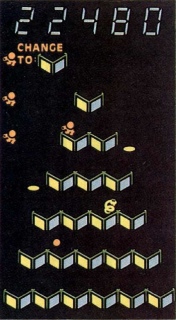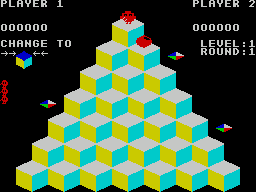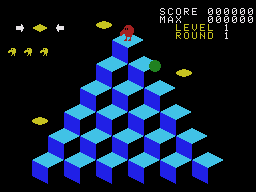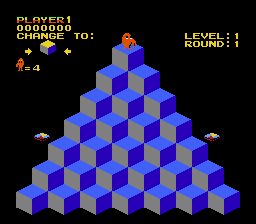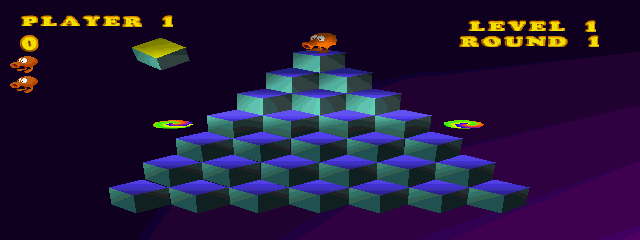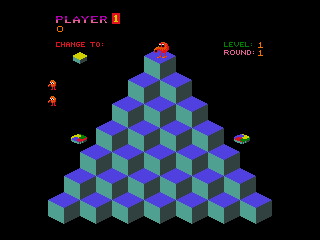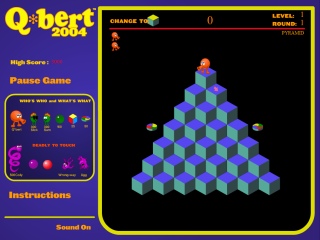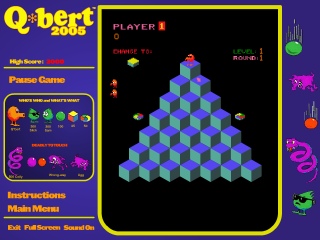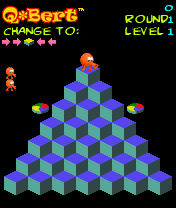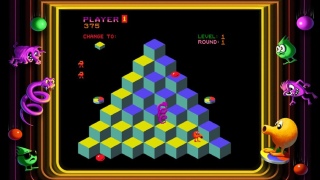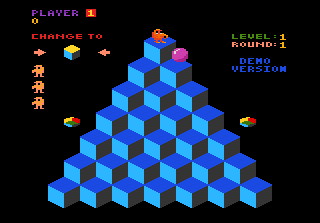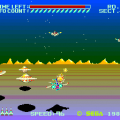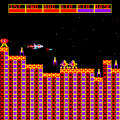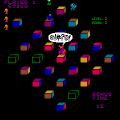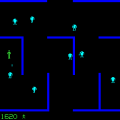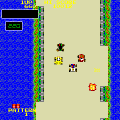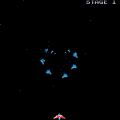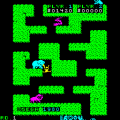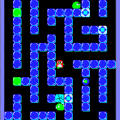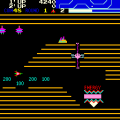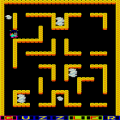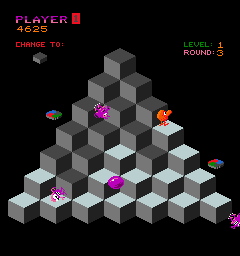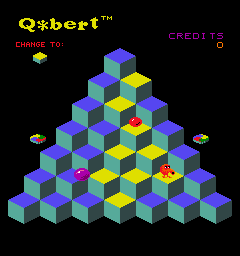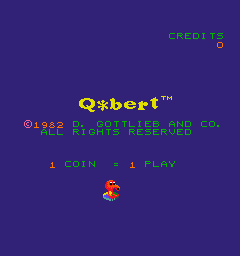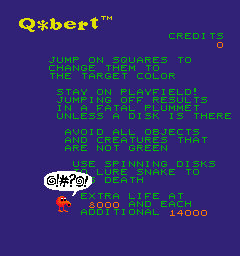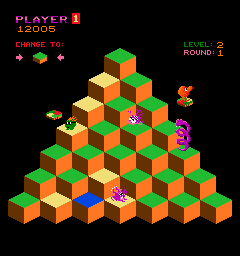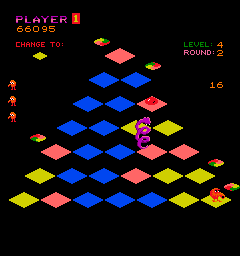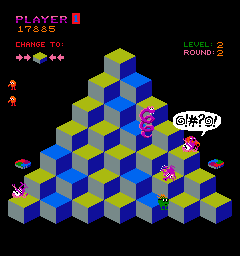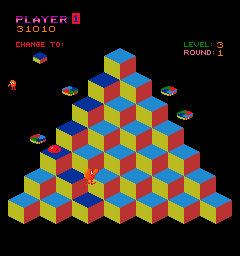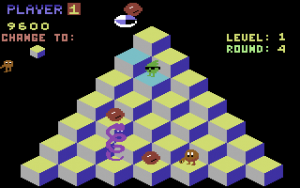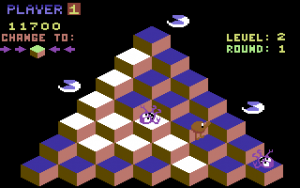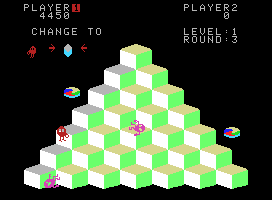Most millennials probably know Q*bert as one of the frustrated forgotten characters in Wreck-It Ralph, and that is actually kind of the character’s true story. In the time before the great video game crash of the mid-1980s, Q*bert was the next big arcade smash hit after Pac Man and Donkey Kong. Within few months after his debut, the cute little “noser” had already become a merchandise behemoth, around whom pinball specialist Gottlieb built much of its show presence at the Amusement Operator’s Expo that was held from March 25th to 27th, 1983. But since then has succumbed into obscurity. The reason for this may be that, other than Nintendo and Namco, who kept curating their IP through the decades, Q*bert spent most the time owned by entities that didn’t rightly know what to do with him – his supporting role in Wreck-It Ralph can only be considered one of the relative highlights.
From Snots and Boogers to Q*bert
And it all started out so promising! Although there have been small location tests before, Q*bert‘s first big showing was at the 1982 AMOA trade expo (November 18th-20th), where it was immediately identified as a future hit and by many considered the star of the show. Granted, Q*bert‘s franchise appeal was probably owed more to Jeff Lee’s fantastic (and fantastically marketable) characters rather than the gameplay, but it still was a very inventive take on what would eventually develop into the “platformer” genre, and possibly the first that could be considered an action puzzle game, although the emphasis was still on the action. The fact that the game design is so good is even more impressive when considering that it started simply with some doodles and the drawing of an M.C. Escher-like pyramid, and programmer Warren Davis (with the help and suggestions by other Gottlieb staff) made the rest of what the game would be up as he went. It may seem simple and quaint now, but back in its time, it was very much deserving of the title for “Most Innovative Coin-Op Game” of the year that Electronic Games awarded to the game.
One of the biggest challenges in the creation of Q*bert didn’t have anything to do with the design or programming, though – the guys at Gottlieb had a lot of trouble finding a name for the thing. Character designer Jeff Lee originally meant to call his creation ‘Snots and Boogers’ – a super awesome gross-out name for the kids who would have played it under that name, but probably not too appealing from a marketing standpoint. It also didn’t make much sense for the final game concept, which dropped the idea of Q*bert shooting enemies with the products from his nose.
The next serious contender for a title was even worse. One of Q*bert’s peculiarities as a character was his rampant swearing – echoing the reactions of countless players, the noser would scream angry curses whenever he was caught by an enemy – it was just some garbled “voice synthesis” generated from random values and a few unintelligible symbols in a speech bubble, but the message got across. And then someone decided that the unintelligible symbols should become the game’s title. As Warren Davis explained to Retro Gamer (No. 54, p. 72): “Our vice president of marketing, Howie Rubin, wanted to name the game ‘@!#?@!?’, and even though pretty much everyone thought that was ridiculous, a number of games went out on test with that name on the marquee.” According to Davis, about 50 titles where suggested, one of them ‘Arnie Aardvark’. Eventually someone came up with the name ‘Hubert’ for the protagonist, which was then frankenworded with ‘cube’ and spiced up with a trendy spelling.
A new perspective
Q*bert was not the first video game ever to apply an isometric perspective – Sega’s Zaxxon predates it by several months – but its diagonally adjusted joystick reportedly posed a challenge to many first time players. It actually makes a lot of sense, though, and it’s easy to get the hang of it even when playing it on a keyboard without the 45 degrees tilt. The title is often described as an early platforming game, but hopping is Q*bert’s only, automatic mode of movement, so no additional buttons are required to play. (To Edge Online, Warren Davis declared: “I was proud to have made a game you could play while holding a drink in your hand.”)
Q*bert’s task in every stage is to hop on all the pyramid blocks to change their color to a target. This starts fairly easy when every tile has to be stepped on just once, but eventually grows more challenging. After every four rounds, Q*bert reaches a new level, which further complicates the rules. First there are tiles whose color has to be changed twice, then they revert back each time Q*bert passes over them again, and finally the two concepts get combined in varying forms. Thus the game gradually grows from a pure twitch-action affair into more and more of a puzzle game. In the higher levels it’s easy to end up with a seemingly (on first look) unresolvable leftover tile, and getting quickly through the stage requires clever planning.
Of course, Q*bert isn’t left to his own devices on the pyramid, and over the first few rounds a range of hazards and adversaries are introduced. Warren originally approached the game as “an exercise of programming randomness and gravity by having balls drop down a pyramid of cubes,” (Retro Gamer #54, p. 71) and those balls are the most prevalent trap to thwart the paint job. Occasionally one of them is colored purple instead of red, and that one hatches into an aggressive snake named Coily when it reaches the bottom floor. Coily relentlessly hunts down Q*bert, but he can trick the serpent by luring it close to one of the flying discs placed at the borders of the pyramid and then jumping across, watching as Coily leaps to its doom.
The Escher pyramid is effective in distracting the eye, and it’s not uncommon for it to be “flipped around” in a player’s perception, making for a bit of confusion. But the concept is only fully explored when the next pair of opponents arrives: Wrongway is turned around by 90 degrees counter-clockwise, and hops along the visible left side of the cubes, while Ugg is just the other way round, jumping from right side to right side. They wander around more or less aimlessly in a horizontal direction, but their orientation makes it hard to guess where Q*bert will be save from them at the next step.
Slick and Sam, finally, aren’t all that bad. They kind of hinder the orange hero by swapping back the colors of the tiles they touch, but don’t actually harm him, and even award points when the player manages to catch them on their way. There’s also a green ball falling down occasionally, which can stop any enemy movement for a short time.
Q*bert starts out fairly easy and takes a while to ramp up the difficulty, but then it becomes very hectic and hard to keep under control. Unfortunately, that means that after a few hours of practice the first couple stages get a bit boring, and as soon as things get interesting, the game can be over fast. The PCB has a dip switch that allows to skip rounds, but that also grants unlimited lives at the same time. An in-game level selection would have been more desirable. The game also gets rather predictable, as enemies always spawn from the same few spots and have very limited (though randomized) movement patterns. Regardless of the changes in color swapping patterns, all stages still take place on the same pyramid.
Part of Q*bert‘s appeal in the early 1980s was its audiovisual presentation. The sprites are adorable, and the bright colors make it stand out from most of the contemporaneous crowd of arcade games, but it was the sound that really sold the game. The swearing allegedly came from Gottlieb’s sound engineer David Thiel experimenting with synthesized voice, but since he had a hard time getting it to produce any intelligible speech, he just made the program blurt out gibberish based on random parameters. The result became one of the character’s trademark characteristics, and was used or imitated in the cartoon (where Q*bert speaks normally otherwise) and most of the later sequels.
But it wasn’t just the hero’s angelic voice that captured the masses. The jingles in between stages is also catchy, and while there is no music during gameplay, Q*bert and Coily emit sounds with every step, creating a hypnotizing rhythm of bleeps. Or, as Vidiot puts it: “The rhythm of Q*bert’s jumping sounds are highly mesmerizing, deceptive, generating a pulse that one instinctively wants to regulate, like a heartbeat.” When Q*bert falls off he pyramid, players of the original arcade cabinet actually hear a physical clunk generated by a pinball table part smashing against the inner wall. That’s apparently what you get when you have a pinball company making video games.
Alternative Q*berts
Among the many pieces of cross-marketing for Q*bert was a special edition of the arcade game titled Mello Yello presents Q*bert – at the time the Coca-Cola Company, who sold the soft drink, owned Columbia Pictures, who in turn owned Gottlieb. The game was exactly the same, but it had a new cutscene where Q*bert got to enjoy a can of Mello Yello after every other round.
Since all the kids soon mastered Q*bert and were playing the game for hours on a single quarter – the game doesn’t get any harder beyond stage 9 and goes on indefinitely – Warren Davis programmed a faster, harder, more challenging Q*bert, which was aptly named Faster Harder More Challenging Q*bert. Here the more difficult tile swapping rules get applied much faster and flying discs keep moving along the pyramid border (but in turn they reappear indefinitely, allowing for entirely new heights in score). Starting from Level 2, the enemies learn a new mean trick – Slick and Sam now block all tiles they pass through, and the only way to free them is to lure Coily over them. Level 3 introduces a new enemy type – Q*bertha, a goofy-looking female counterpart of Q*bert, who chases him around to catch a kiss. She combines the movement pattern of Coily (whom she replaces) with the color reverting ability Sam and Slick used to have. At the latest on level 4, when Q*bertha and Sam/Slick appear in tandem, there’s hardly any breathing room left for poor little Q*bert. There’s also a bonus round where Sam and Slicks just keep storming the pyramid, and the player is awarded bonus points for every caught enemy and every conquered tile. All these new elements result in a much more interesting and varied experience. The only problem: Mylstar (Gottlieb’s new name) ended up never shipping the update. Davis eventually released the ROM to the public so it could be played in emulators. He considers it to be the definitive version of Q*bert, and he is right.
Porter Brothers
Parker Brothers (Montezuma’s Revenge) secured the license for home conversions, and did their usual near-complete sweep of the available platforms at the time. The port for the Odyssey² was naturally very crude, and the floor tile are represented by simple rectangles. With the Escher look gone, Wrongway and Ugg end up simply moving around the same surfaces as everyone else. There are also some weird balancing changes. Round 2, for example, introduces all the enemy types at once, while in round 3 Q*bert almost has enough time to clear all tiles before even one ball spawns at the top of the pyramid. The Atari 2600 version does display cubes for the floors, but they still look nothing like an Escher painting and are oddly spaced. Wrongway and Ugg don’t appear at all here, but without them, the game gets a bit monotonous. The pyramid consists of only 21 tiles on 6 floors, compared to the original 28/7. This feature is shared by the Intellivision and Commodore VIC-20 ports. The Intellivision manages an otherwise reasonably similar look to the arcades, but the VIC-20’s lack of proper sprite capabilities means that it runs and looks terrible.
The rest of Parker Brothers’ versions are the same as the arcade game, aside from the usual graphical differences. Surprisingly, the TI-99/4A manages to look best, but it twists the controls by 45 degrees, and in the other direction as all the other ports, which is very counter-intuitive. More playable is the Atari 5200 version, which actually takes diagonal input from the joystick. (The Odyssey², Intellivision and IBM PC ports do, too, but they don’t look as good.) A version for the ZX Spectrum was programmed but never published in the UK, although it seems that it was released for Sinclair’s US model Timex Sinclair 2068. In Japan, Tsukuda Original brought Q*bert to the Othello Multivision (a computer compatible with the Sega SG-1000/SG-3000). This also only features six pyramid floors, but it’s really fast-paced, with balls falling like crazy, and very odd positioning for the flying discs from the very beginning.
For a long time the final official release of the original Q*bert came for the NES in 1989, which seems to have been exclusive to North America, despite being ported by Konami. It’s most distinctive feature is the option to map movement to any directions on the d-pad, including diagonals. It is also the only version to have an ending screen to congratulate the player upon finishing the “final” round, before the levels would just start looping. Otherwise, it’s a no-frills exact port.
It took ten more years until Hasbro Interactive revived the franchise. The new game that was also labeled just Q*bertfor PlayStation, Dreamcast and Windows PCs contained a classic mode that recreates the arcade game, either with 3D graphics or the original pixel art. Several versions of the Flash sequels Sony Pictures put out in 2004 and 2005 also contain the original arcade game, sometimes with newly drawn sprites, sometimes with the old graphics. All these versions support mouse controls, but those feels really weird with Q*bert even though they technically work pretty well. Worse is the terribly slow pacing. At least Q*bert 2005 was also available as a Windows executable. Afterwards, Sony brought Q*bert to a range of download platforms, including Java-based mobile phones, the iPhone and PSN. Most of these were just the basic arcade game again (although the iOS port also offered some of the added content from the Flash games). But those have all been delisted off the respective services, so the only ways to legally play Q*bert – short of acquiring the arcade machine – involve to either track down any free versions of the Flash games, or get one of the old imperfect ports.
If strict legality is not a concern, then there are several faithful fan remakes available. PC*bert for MS-DOS was released in 1997 and is a far cry from the old official PC port. It’s almost identical to the arcade version, but also has nothing MAME can’t offer. b*nQ was published in 2007 through AtariAge and brought the classic game to the criminally neglected Atari 7800. It runs a bit choppy (at least in emulation) and has rather unpleasant sound, but otherwise it’s a very good translation, and offers four different difficulty levels.
Contemporary Press:
Mike Pugliese: The AMOA Show – Gottlieb in Coin Slot 1/1983, page 28.
Michael Blanchet: Screen Plays – Qursing Q*bert: @!#?@! you, Coily! in Electronic Fun 3/1983, page 92.
Top Ten Hits – (1) Q*bert (AMOA 1982) in Video Games 3/1983, page 66.
Q*bert in AM Life 3/1983, page 10 (Japanese).
Neil Tesser: The Life and Times of Q*bert & Joust 1 2 3 4 5 in Video Games 4/1983, page 26-30.
Crazy for Q*bert’s Cube 1 2 in Vidiot 4,5/1983, page 30-31.
Roger C. Sharpe: Is This the Next Arkie Winner? – Q*bert 1 2 in Electronic Games 5/1983, page 79-80.
Dan Gutman: The World According to Q*bert 1 2 3 4 in Video Games Player 8,9/1983, page 46-48, 66.
Randy Hacker: Q*bert’s 20,000 point pyramid in Electronic Fun 11/1983, page 58.
Marc Berman: Q*bert (ColecoVision) in Electronic Fun 12/1983, page 62.
Dan Persons: Q*bert (2600) 1 2 in Video Games 12/1983, page 65-66.
Will Richardson: Get Hopping with Q*bert! in Electronic Games 1/1984, page 102.
The 1984 Arkie Awards – Most Innovative Coin-op Game in Electronic Games 1/1984, page 80.
Joyce Worley: The Block Bouncer Busts Loose 1 2 3 4 in Electronic Games 1/1984, page 122-125.
Mark Brownstein: Follow the Leader 1 2 3 4 in Video Games 3/1984, page 28-31.
Q*bert (Intellivision) in Video Games 4/1984, page 60.
Dan Gutman: The Clones of Q*bert 1 2 3 4 in Computer Games 4/1984, page 48-51.
Q*bert (C-64) in Computer Games 6/1984, page 60.
Links:
Coinop.org – The Creation of Q*bert by Warren Davis.
Tomorrow’s Heroes – Q*bert Interview with Warren Davis.
The A.V. Club – Q*bert co-creator Jeff Lee.
The History of Q*Bert: As recalled by Jeff Lee (archived).
Edge Online – The Making of Q*bert.
